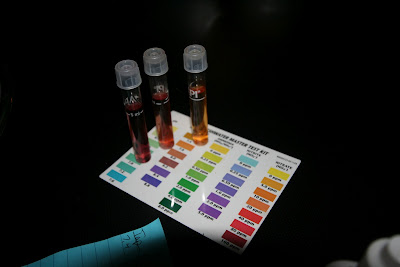Nitrogen Cycle
 |
| Nitrogen Cycle |
The fish produce waste, and there is usually some food floating around that does not get eaten. These two when let to sit in an aquarium, start to break up, and this creates ammonia. This is the first step in the nitrogen cycle. While ammonia starts the cycle, it is very dangerous and deadly to fish if the ppm (parts per million) gets too high.
The nitrogen cycle has two naturally occurring bacteria that do most of the work. The first bacteria to aid in the nitrogen cycle is nitrosomonas. This bacteria converts ammonia into nitrites. Fish can tolerate nitrites more than they can ammonia, but it can still be toxic to them.
Nitrospira is the secnond naturally occurring bacteria that aids the nitrogen cycle. Nitrospira consumes the nitrite produced by nitrosomonas and produces nitrates as a byproduct. Nitrates are much safer for fish than either ammonia or nitrites. However if there is nowhere for the nitrates to go and they are not being consumed, it can kill your fish.
In a home aquarium, the nitrates are removed by doing water changes, or if there are plants in the aquarium, they will consume the nitrates, which is essentially plant food.
In aquaponics, we not only grow veggies, fruits, and fish, we also cultivate these bacteria. Without nitrosomona and nitrospira, aquaponics would not work the way it does. We use their by-products to feed our plants so we do not need to add fertilizers.
So the key to aquaponics is producing enough nitrates for your plants to grow, and having enough plants to consume the nitrates. While reading up on different filters for my aquarium (before I converted to aquaponics), I came across moving bed filters.
Moving Bed Filter
A moving bed filter in short is a nitrate factory. It uses small filter media that have extreme amounts of surface area to catch all the bacteria that flow through the filter. The idea is very similar to the way aquaponics works. The filter media cultivate the same naturally occurring bacteria, nitrosomonas and nirospira. Theses filter the water like a mini nitrogen cycle. The filter media is designed to work best when they are moving around in the water, hence its name.
 |
| Tilapia Approved! |
Moving bed filters use nontraditional filter media. Many products can be used but through my research I found that Hel-X. Hel-x has 40% more surface area than its competitors and comes in an array of sizes.
 |
| Close up of Hel-X filter media. The surface area on these are impressive! |
Usually aquaponic systems do not have filters (well Deep Water Culture does but...), however I believe adding this type of filter would be a huge benefit to aquaponic systems.
When I met Alex Blackwell, I brought with me a bag of Hel-X media. The idea was to build a moving bed filter for his system. After a day or two of collaboration and brainstorming, we got the idea of using a moving bed filter as a prefilter for his pump.
Alex's pump is in the fish tank and the mechanical filter it came with got clogged weekly with all the fish waste. This slowed the flow rate and turned the water a murky brown color, not the best. We designed and added the moving bed filter to the pump. The pump pulls the water through the moving bed filter and stirs up the Hel-X. It works amazingly!
 |
| The filter has cleaned the water and increased the flow rate. Once the bacteria is fully established, it will provide filtration and nitrates for the plants. |
The moving bed filter in the Blackwell system cleaned up the water and increased flow rate. Once the bacteria has a chance to colonize the Hel-X the filtration will consume the ammonia and decrease ammonia spikes. Plus once it is established, it will be pumping extra nitrates into the grow bed each time the pump runs, which is 15 minutes of each hour.

















